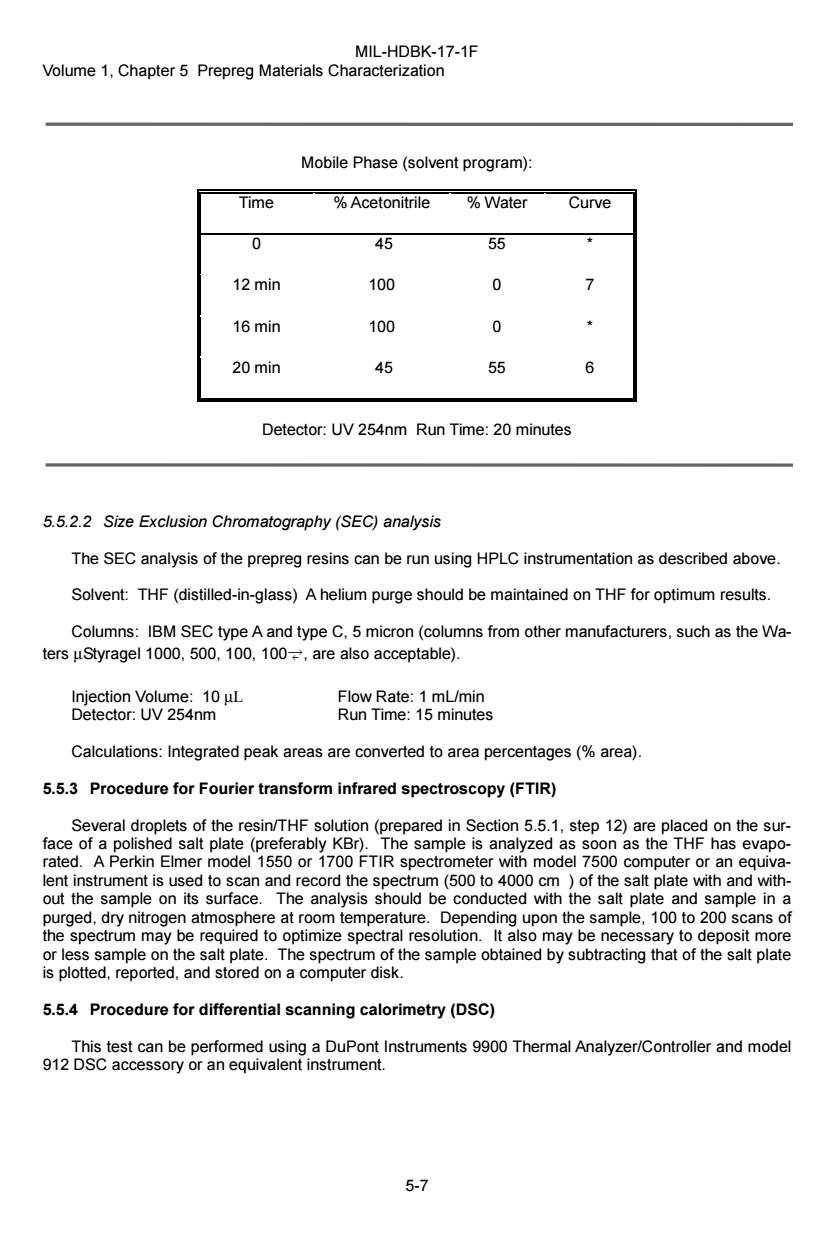正在加载图片...

MIL-HDBK-17-1F Volume 1,Chapter 5 Prepreg Materials Characterization Mobile Phase(solvent program): Time Acetonitrile %Water Curve 0 45 55 12 min 100 0 7 16min 100 0 20 min 45 55 6 Detector:UV 254nm Run Time:20 minutes 5.5.2.2 Size Exclusion Chromatography(SEC)analysis The SEC analysis of the prepreg resins can be run using HPLC instrumentation as described above Solvent:THF(distilled-in-glass)A helium purge should be maintained on THF for optimum results. Columns:IBM SEC type A and type C.5 micron(columns from other manufacturers,such as the Wa- ters uStyragel 1000,500,100,100-,are also acceptable). Injection Volume:10 uL Flow Rate:1 mL/min Detector:UV 254nm Run Time:15 minutes Calculations:Integrated peak areas are converted to area percentages(%area). 5.5.3 Procedure for Fourier transform infrared spectroscopy(FTIR) Several droplets of the resin/THF solution (prepared in Section 5.5.1,step 12)are placed on the sur- face of a polished salt plate(preferably KBr).The sample is analyzed as soon as the THF has evapo- rated.A Perkin Elmer model 1550 or 1700 FTIR spectrometer with model 7500 computer or an equiva- lent instrument is used to scan and record the spectrum(500 to 4000 cm )of the salt plate with and with- out the sample on its surface.The analysis should be conducted with the salt plate and sample in a purged,dry nitrogen atmosphere at room temperature.Depending upon the sample,100 to 200 scans of the spectrum may be required to optimize spectral resolution.It also may be necessary to deposit more or less sample on the salt plate.The spectrum of the sample obtained by subtracting that of the salt plate is plotted,reported,and stored on a computer disk. 5.5.4 Procedure for differential scanning calorimetry(DSC) This test can be performed using a DuPont Instruments 9900 Thermal Analyzer/Controller and model 912 DSC accessory or an equivalent instrument. 5-7MIL-HDBK-17-1F Volume 1, Chapter 5 Prepreg Materials Characterization 5-7 Mobile Phase (solvent program): Time % Acetonitrile % Water Curve 0 45 55 * 12 min 100 0 7 16 min 100 0 * 20 min 45 55 6 Detector: UV 254nm Run Time: 20 minutes 5.5.2.2 Size Exclusion Chromatography (SEC) analysis The SEC analysis of the prepreg resins can be run using HPLC instrumentation as described above. Solvent: THF (distilled-in-glass) A helium purge should be maintained on THF for optimum results. Columns: IBM SEC type A and type C, 5 micron (columns from other manufacturers, such as the Waters µStyragel 1000, 500, 100, 100S, are also acceptable). Injection Volume: 10 µL Flow Rate: 1 mL/min Detector: UV 254nm Run Time: 15 minutes Calculations: Integrated peak areas are converted to area percentages (% area). 5.5.3 Procedure for Fourier transform infrared spectroscopy (FTIR) Several droplets of the resin/THF solution (prepared in Section 5.5.1, step 12) are placed on the surface of a polished salt plate (preferably KBr). The sample is analyzed as soon as the THF has evaporated. A Perkin Elmer model 1550 or 1700 FTIR spectrometer with model 7500 computer or an equivalent instrument is used to scan and record the spectrum (500 to 4000 cm ) of the salt plate with and without the sample on its surface. The analysis should be conducted with the salt plate and sample in a purged, dry nitrogen atmosphere at room temperature. Depending upon the sample, 100 to 200 scans of the spectrum may be required to optimize spectral resolution. It also may be necessary to deposit more or less sample on the salt plate. The spectrum of the sample obtained by subtracting that of the salt plate is plotted, reported, and stored on a computer disk. 5.5.4 Procedure for differential scanning calorimetry (DSC) This test can be performed using a DuPont Instruments 9900 Thermal Analyzer/Controller and model 912 DSC accessory or an equivalent instrument